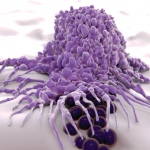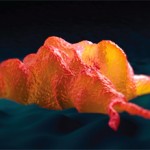Fibrosis
Niels Camara, PhD, associate professor of immunology at the University of Sao Paolo in Brazil, described insight his lab has made into the role of M1 macrophages in fibrosis of the kidney.1 Researchers found that animals subjected to ischemia suffer a large amount of apoptosis and necrosis, but with the infiltration of cells relatively mild. After seven days, the animals fully recovered.
“Six to eight weeks later, you can see an infiltration of macrophages and also deposition of collagen,” Dr. Camara said. “So we know this happens because of inflammation. Inflammation is the big link between an acute and chronic injury.”
Researchers homed in on the role of M1 macrophages, which are distinct from M2 macrophages in appearance, what they do and how they perceive their microenvironment, he said. “Normally, when you induce a disease in an animal model, what you see is a chronic and sustained inflammation—the degree of inflammation is low as time passes, and you also see [depending on the model] the presence of M1 macrophages. That’s why we believe that M1 macrophages could very well be inducing fibrosis,” Dr. Camara said.
They set out to find out what drives this infiltration. They found that macrophages in the hypoxic conditions that are frequent in the kidney lead to the release of uric acid. “If I put macrophages under hypoxic conditions, 24 hours is already enough to see an increase in uric acid” in wild-type mice, Dr. Camara said.
Crystals from uric acid can activate the inflammasome, previous studies have found. But his lab found that the soluble form of uric acid in their experiments also has this effect.
The inflammasome is related to the metabolic control of the cells, and M1 macrophages seem to have effects through metabolic pathways as well, he said.2
“Metabolism is relevant in understanding how macrophages work,” Dr. Camara said. “M1 macrophages are related to fibrosis through activation of the inflammation of the inflammasome and the metabolism.”
Thomas R. Collins is a freelance writer living in South Florida.
References
- Camara NOS. Macrophages, metabolism and inflammation (abstract SP0105). Annual European Congress of Rheumatology. 2017 Jun 15. Madrid, Spain.
- Moon JS, Hisata S, Park MA, et al. mTORC1-Induced HK1-dependent glycolysis regulates NLRP3 inflammasome activation. Cell Rep. 2015 Jul 7;12(1):102–115.


